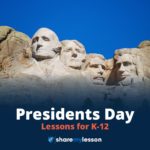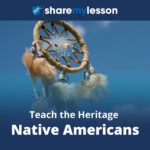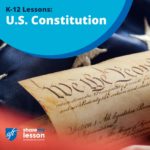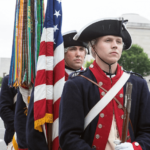On July 4 each year, the United States celebrates Independence Day. This day commemorates the signing of the Declaration of Independence on July 4, 1776, in which citizens of the thirteen American colonies announced their break from the British Empire and their intention to form a new nation: the United States of America. This Share My Lesson collection provides educators with free preK-12 lesson plans, activities, and materials to use to teach their students about Independence Day.
Constitution Day Word Search
Here’s a fun activity for all ages with vocabulary that is tied to Constitution Day! Answers are provided as well!
Presidents Day Lesson Plans & Resources

Presidents Day was originally established in 1885 as “Washington’s Birthday” to celebrate President George Washington’s birthday on February 22. In 1971, the federal government renamed the holiday Presidents Day in order to honor all U.S. presidents, past and present. Share My Lesson has curated a collection of free lesson plans, educational resources and classroom materials on the accomplishments of U.S. presidents, first ladies, and the role and responsibilities of the president in government and in a democracy.
Constitution Day Writing Prompts – Middle and High School
Three writing prompts for Constitution Day are provided for middle school and high school. The prompts can be used as a formal essay, at writing stations, or as a “discuss and write.”
Indigenous Peoples and Native American Lesson Plans & Resources

November is National Native American Heritage Month, and now more and more schools are recognizing Indigenous Peoples Day, in lieu of Columbus Day, on the second Monday in October. Share My Lesson has curated this collection of free lessons, activities, and videos to assist educators in teaching about the ways of life of indigenous peoples from around the world in order to foster understanding of our shared sense of humanity.
Making the Constitution (CKHG Unit)
Students who listen to this Grade 2 Core Knowledge History and Geography unit discover that Americans had a difficult task at hand after winning the Revolutionary War: they had to figure out a better way to govern themselves. Such leaders as James Madison, George Washington, Alexander Hamilton, and Benjamin Franklin traveled to Philadelphia to meet at the Constitutional Convention, with the goal of creating a new government. Students learn that the talks were held in secret in Independence Hall and that American leaders argued about many issues until they agreed to approve a new Constitution. They then hear that James Madison (whom we call the Father of the Constitution), along with John Jay and Alexander Hamilton, wrote the Federalist Papers to explain the document’s merits and to persuade the states to vote for it. Students find out that the states did finally approve the Constitution; that Madison wrote a Bill of Rights that was added to it; that the Constitution gives the American people the right to decide what the laws should be for our country; and that we can still amend it today.(5 lessons)
Declaration Revisited: Declaration of Sentiments Podcast
The Declaration of Independence called George III a tyrant. And in 1848, a group of women’s rights activists mirrored our founding document to accuse men of the same crime. Today in our final revisit to the Declaration of Independence, we explore the Declaration of Sentiments, the document at the heart of the women’s suffrage movement.
Our guest is Laura Free, host of the podcast Amended and professor at Hobart and William Smith Colleges.
This short episode includes a one-page Graphic Organizer for students to take notes on while listening, as well as discussion questions on the back side.
Distance Learning: Civics for Civic Engagement in the Federal Courts
Distance learning activities become civics for civic engagement when federal judges bring the rule of law, separation of powers, judicial independence, and jury service into students’ daily life. Student voice is incorporated into every activity. Teachers and students can explore the pillars of literacy: rule of law, separation of powers, and judicial independence. With the guidance of federal judges and attorney volunteers in virtual court hearings, students learn and practice civil discourse skills as the foundation of effective dispute resolution in the law and in life.
Choosing to Make a Nation: Constitutional Convention Simulation
The Choosing to Make a Nation Curriculum Project developed by award-winning author Ray Raphael is a student-centered, primary source-rich approach to teaching about American history and our nation‘s founding documents.
An 8-lesson simulation in which students become delegates from specific states and address the same issues the framers faced. Unit includes the following lesson plans –
(1) Reform or Revolution?
(2) Composition of Congress
(3) Creating an Executive Branch
(4) Should Judges Judge Laws?
(5) Balance of Powers
(6) Slavery and the Constitution
(7) Amendments and Ratification
(8) To Sign or Not to Sign?
Option A: The historical Constitution
Option B: Student-generated constitution
Constitution Day Activities & Lesson Plans

Get ready for September 17, Constitution Day, with these preK-12 Constitution Day activities and lesson plans on the U.S. Constitution. The Share My Lesson team has selected a variety of free lesson plans, educational resources, and classroom materials to support teachers in celebrating Constitution Day with their students.
